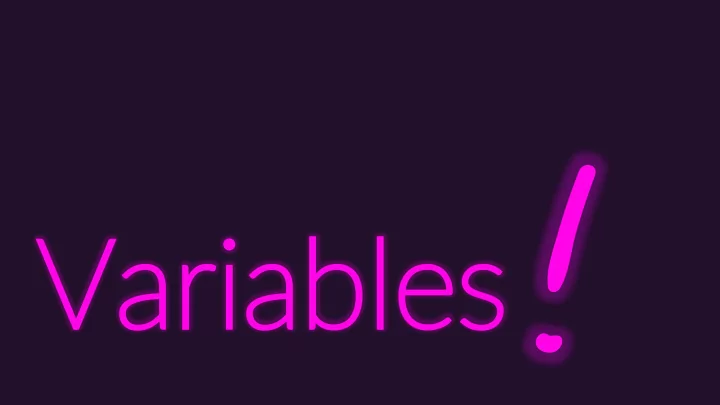

Variables
Varia iables • Variables allow your programs to store, load , and change values in memory. Current Scope • Every variable: age 20 int 1. has a name and 2. is bound to a value of a specific data type
How to use a variable, generally.. ... 1. Declare the variable with name & type Declare 2. Initialize / Assign variable its first value (Steps 1 and 2 can be combined!) Initialize / Assign Once 1 and 2 are done, then you can*: • Access the value stored in a variable, or, Access / "Read" Reassign / "Write" • Reassign new values to the variable * There are additional rules governing where you can access and assign a variable from.
Varia iable Declaratio ion Syntax (1/3) • When you declare a variable, you are proclaiming... “henceforth, the identifier <some name> shall be bound to a(n) object of <some type> stored in memory” age: int • “the identifier age shall refer to an int value stored in memory.” • General form: [identifier]: [type] • The type can be: int, float, str, bool (and many more types to come!) 4
Varia iable Name & Id Identifier Rules (2 (2/3) Variable names are an example of an identifier . Identifiers cannot contain spaces, must begin with a letter or underscore, and contain only letters, numbers, and underscores. In Python, it is traditional to use for multiword variable names. For example, a variable to store "year of birth" would be named: 5
Pythonic: : Dunderscore Identifiers (3 (3/3) Python surrounds special identifiers in double underscores called dunderscores Example: __author__ These are identifiers Python assigns special meaning to. We'll see more! __init__ __name__ __repr__ __str__ This is a Pythonic Idiom ! Each language has its own idioms for similar purposes. 6
Varia iable Assignment Syntax (1 (1/4) • The assignment statement binds a value to a variable • “ age is bound to the value 21 ” • "age is assigned 21" • “ age takes the value of 21 ” • “age is now 21” • Notice: None of these readings uses the word “equals”! • General form: • The single equal symbol's name is the assignment operator . 7
Varia iable Assignment Semantics (2 (2/4) When this line of code runs: Current Scope - after age = 20 evaluates age = 20 age 20 The identifier age is bound to a space in memory holding the value 20. Later, if the following line ran: age = 21 Current Scope - after age = 21 evaluates The identifier age is now bound to a space in age 21 memory holding the value 21. Assignment is not equality! 8
Varia iable Assignment Rules (3 (3/4) • A variable’s value can change as the program runs • Just assign another value to the same variable! • After an assignment statement evaluates, when a subsequent line of code accesses the variable it will have the most recently assigned value. • The assignment operator is not commutative! [identifier] = [expression] # OK [expression] = [identifier] # NOT OK The variable's name must be on the left of the assignment operator (=) and the value being assigned must be on the right. • You should not refer to a variable until after its name defined and bound! • • • For COMP110: expression's type must match the variable’s declared type 9
Varia iable Assignment Rules - Expressions (4 (4/4) • Notice the right-hand side (RHS) of assignment is an expression ! [identifier] = [expression] • Remember! Every expression evaluates to a single value at runtime . • To know what value the variable name will be bound to, the expression of an assignment statement must first be evaluated. Current Scope - after age = 20 + 3 evaluates • If the following line ran: age 23 1. The computer evaluates the RHS expression 2. The name age is bound to the result of it 10
Variable In Init itialization (1 / 2) • Initialization is the first time you assign a value to a variable. • After initialization a variable is considered defined or "bound". • Always, always, always initialize your variables! • You can declare and initialize it in two steps: lucky: int lucky = 13 • Or, you can combine these steps into a single statement: lucky: int = 13
Variable In Init itialization – Type In Inference (2 / 2) • Notice there is some redundancy in this statement: lucky: int = 13 • "Let lucky be an int variable that is initially assigned the int 13." • If you combine declaration and initialization, a modern programming language will infer the variable's type for you. So you can write: lucky = 13 • You are encouraged to use type inference when you know a variable's initial value at declaration.
Variable Access Expression – "Read" (1/2) • After you have declared a variable and Current Scope initialized it… age 20 • You can access ("read", "look up") a variable’s value in memory by its name age • “Find the name age and evaluate to its bound value.” • Caution! This is very different than: • This is a string literal expression!
Vari riable Access in in an Assignment Statement (2 (2/2) • Consider the following assignment statement: Current Scope 1 2 age = age + 1 age 23 “age is assigned the current value of age plus one” Steps: Current Scope 1. current value of age is accessed ("read") after age = age + 1 evaluates 2. The integer value 1 is added to it age 24 3. age is bound to the resulting value in memory
15
Recommend
More recommend